LD Capital: Mobile 10x DePin track breaks the circle on the eve of old money entering the market
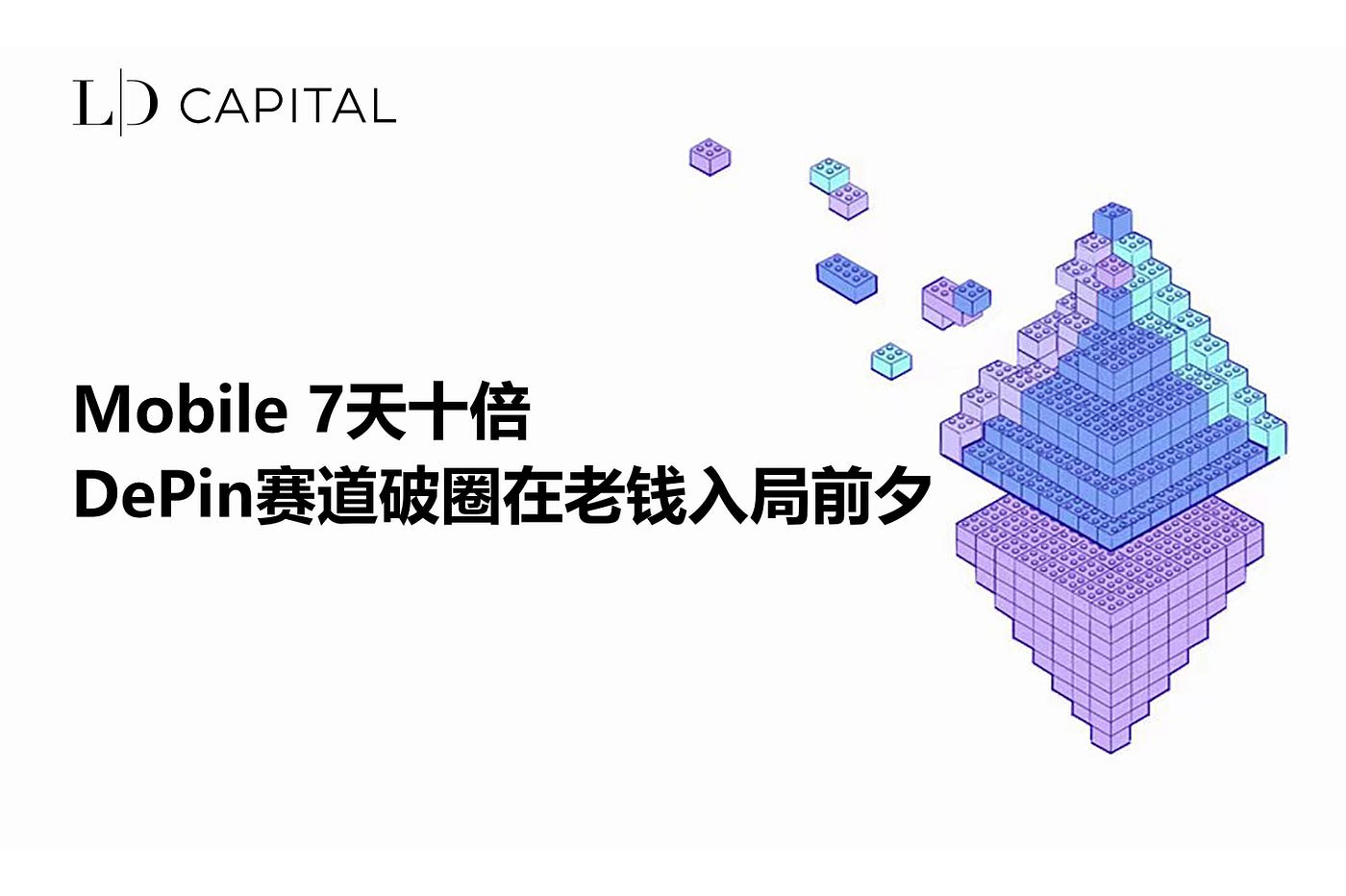
1. Breaking the Circle: The DePin Track on the Eve of Old Money's Entry
DePin stands for Decentralized Physical Infrastructure Networks. At the end of 2021, IOTEX referred to this track as MachineFi. By the end of 2022, Messari introduced the new concept of DePIN for the first time, stating that it is one of the most critical crypto investment tracks in the next decade. In the coming ten years, we can expect traditional institutions to inject incremental funds, and the involvement of traditional capital will disrupt the previous preference for purely on-chain economic speculation surrounding crypto-native applications, shifting towards investment opportunities with more off-chain logic and real-world impact. The importance and investment potential of DePin in the crypto development process align with the demand for new narrative funding in the crypto world.
The core concept of DePin is to use tokens to incentivize users to deploy hardware devices to provide real-world goods and services or digital resources. DePIN can be understood as consisting of two parts: physical resource networks and digital resource networks. Physical Resource Networks (PRN) refer to users providing services such as WiFi, 5G, VPN, geospatial data, and information sharing through hardware distributed across various locations; Digital Resource Networks (DRN) refer to the physical infrastructure networks that provide digital resources through hardware facilities, including broadband networks, storage networks, and computing power networks.
In simple terms, DePIN utilizes hardware to provide resources that may involve software, bandwidth, computing power, etc., to incentivize real-world services that originally required centralized management, making heavy asset services lightweight, decentralized, and solving the cold start problem of projects through more flexible and decentralized node deployment. In the early guiding phase, DePIN adopts a spiraling dynamic mechanism, allowing users, providers, and platforms to participate with relatively low risk. However, the involvement of hardware means that DePIN projects require sufficient upfront capital support to ensure widespread hardware reach, thereby establishing strong network coverage. At the same time, both off-chain and on-chain marketing strategies need to keep pace; the adequate combination of these elements can lay a solid foundation for the success of a DePIN project.
2. DePin on Solana: The Dual Buff of the Strongest Ecosystem and Narrative
DePin on SOL is ranked by market capitalization from small to large as follows: HONEY (Hivemapper), IOT (Helium IOT), Helium Mobile (Helium Mobile), HNT (Helium Network), and RNDR (Render Network), representing specific software applications in the DePin sector (decentralized maps, IOT services, 5G services), IoT infrastructure (decentralized wireless and 5G service platforms), and peer-to-peer rendering computing power matching AI platforms, among other sub-tracks. Among storage-related projects (also considered DePin), Arweave is closely tied to the Solana ecosystem, as most Solana NFTs are stored on Arweave. The following sections will focus on Honey, DIMO, and Helium's Helium and Mobile ecosystems.
2.1 HONEY (Hivemapper)
On Solana, Honey (Hivemapper) is a small-cap DePin track Alpha with a strong investment background and project endorsement.
Hivemapper is a blockchain-based map network that creates a decentralized global map that rewards contributors. Contributors can collect data by installing Hivemapper's dashcam and earn the native token HONEY as a reward. In Hivemapper's setup, the dashcam is equivalent to a "mining machine." Through a seamless mobile application integrated with the Hivemapper network, mapping is placed on autopilot and automatically uploaded. By installing the Hivemapper dashcam, users can mine HONEY token rewards while collecting 4K street-level images to map the world.
The project's designed behavioral incentive goal is to obtain better map data. The quality, timeliness, and urban density of uploaded data become dimensions for evaluating incentive rewards. In terms of quality, the Hivemapper project has created a reputation score driven by the quality of uploaded data. When users capture higher quality images with their cameras installed outside their vehicles, they can earn higher reputation scores. Additionally, the rewards users receive are tied to their reputation scores; the higher their rolling average reputation, the higher their rewards.
Timeliness ensures that street information is up to date. The project has created a so-called freshness score. They essentially created a function that increases over time; if no one collects data for an entire year, the next person to attempt to upload new data will receive a higher multiplier. This promotes timely updates of map data.
Regarding data density, the project aims for a higher concentration of map nodes in several major cities, thus having a massive bonus reward system in the selected 35 cities, giving these places higher reward weights.
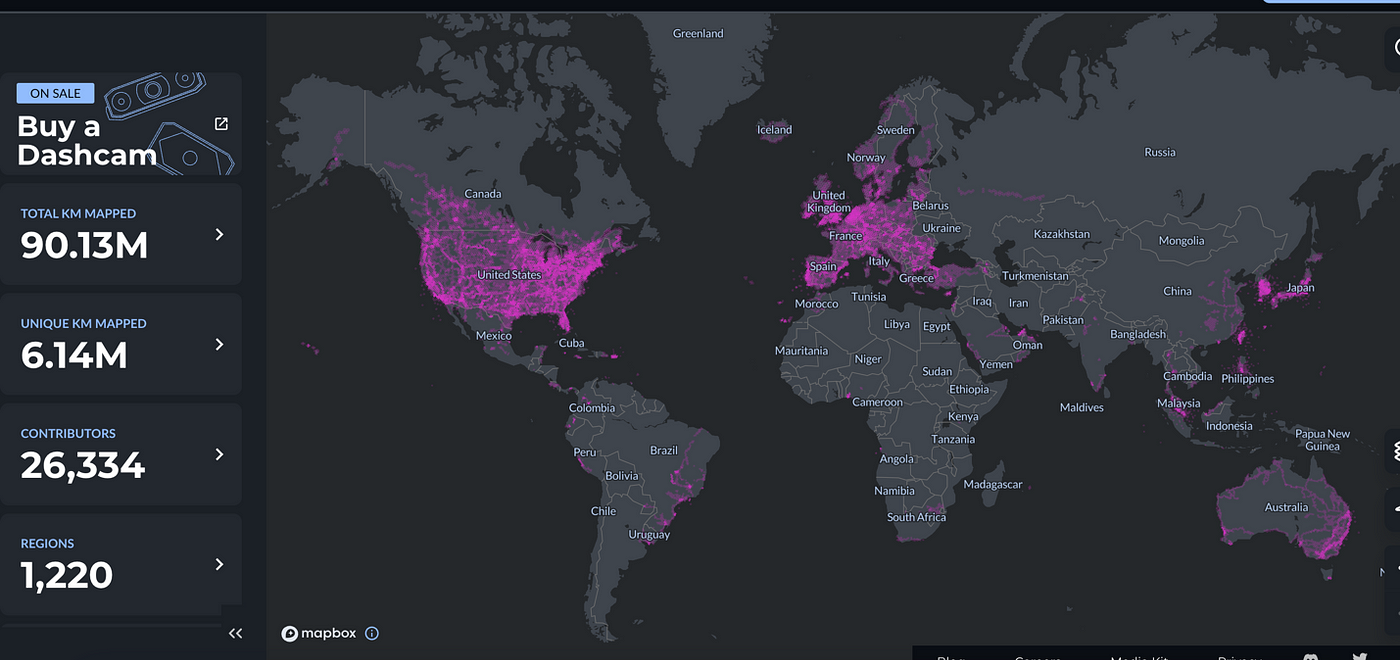
In terms of financing and project background, Hivemapper raised $18 million in Series A funding last year, led by Multicoin Capital, with participation from Craft Ventures, Solana Capital, Shine Capital, Spencer Rascoff's 75, and Sunny Ventures. The previous round was invested by Spark Capital, Founder Collective, and Homebrew. Hivemapper's total funding amounts to $23 million. Amir Haleem, the CEO and founder of Helium, joined the project's board.
Regarding token distribution, Honey's release rules are similar to Helium's, with a maximum supply of 10 billion HONEY tokens, which is a fixed cap. The initial allocation is as follows:
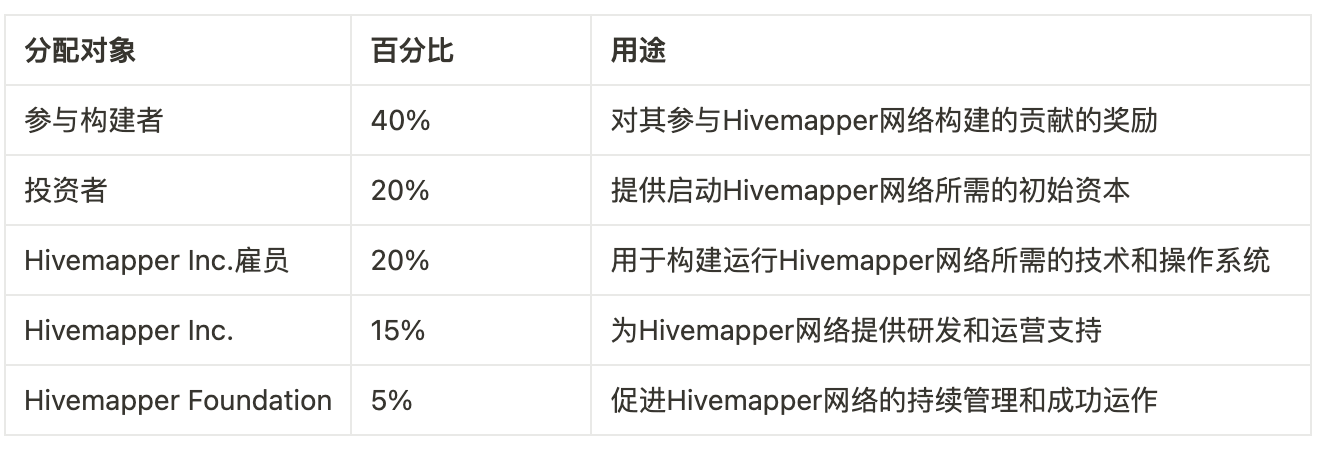
The Hivemapper network began minting and distributing 4 billion HONEY tokens as rewards for contributors. The exact number of tokens minted each week is determined by the global map progress. Currently, the circulating supply increases by about 1.6 million Honey per day.
2.2 DIMO
DIMO, like Hivemapper, belongs to the Drive to Earn track and is one of Hivemapper's competitors.
Compared to Hivemapper, which also focuses on the Internet of Vehicles, DIMO's design is more aligned with user needs, facilitating decentralized acquisition of driving data ownership through incentives, making it easier for end-users to collect data and use it (rewarding car owners and meeting needs like automatic parking/finding parking spaces; the vehicle data collected and shared by car owners can be used in more scenarios), while Hivemapper leans towards B-end products (providing more detailed maps for car manufacturers/related service providers).
The underlying business logic is that the Internet of Vehicles track is backed by a massive market of $450 billion to $700 billion in global automotive data monetization (as of 2023). DIMO links cars and drivers to tokenize driving data, tapping into the global supply chain of data production for 250 million connected vehicles, allowing users to become beneficiaries of driving data profits.
In terms of data usage, Hivemapper and DIMO are relatively close in user numbers, but in terms of FDV, DIMO is smaller. DIMO is an ERC-20 token on the Polygon and Ethereum blockchains, with slightly less project endorsement and not being in a hot ecosystem, thus DIMO started its value discovery later than Honey.

Regarding token distribution, DIMO has a total supply of 1 billion, with baseline rewards accounting for 38%. 380 million DIMO will be distributed over 40 years, with 1,105,000 DIMO issued weekly to users in the first year. The mining rewards for each user are distributed according to the rules in the following chart, with the issuance decreasing by 15% each year; the Dimo treasury accounts for 22%, and teams and individuals contributing to the network may receive $DIMO in the form of bounties or grants; the team accounts for 22%, with token distribution subject to a two-year lock-up, followed by monthly linear unlocking until fully unlocked after three years; investors account for 8%, with token distribution also subject to a two-year lock-up, followed by monthly linear unlocking until fully unlocked after three years; airdrops account for 7%.


Currently, there are 194 million in circulation (including 70 million from airdrops, 57 million already distributed as baseline rewards, and 67 million allocated to the treasury). The initial airdrop was essentially a large-scale distribution of baseline rewards (understood as mining income) (70 million), leaving a remaining 382,491,185 $DIMO. This pool will be distributed over 40 years, with 1,001,050 $DIMO issued weekly to users in the first year, decreasing by 15% each year. The chip structure looks favorable.
2.3 Helium
Helium is a centralized wireless network project (distributed IoT). Founded in 2013, it is a pioneer in the DePIN track. As the most authentic DePin project in the Solana ecosystem, Helium's ecological network is the most mature and relatively stronger compared to other IoT ecosystems. With Helium's support, its ecological project MOBILE has seen a tenfold increase in seven days.
HNT is the main economic asset in the Helium ecosystem, and the only way to pay for network data transmission fees is by burning HNT. Helium's revenue has reached $9,000 per day with the increase in HNT prices, still in a state of insufficient demand, which may be one reason for Helium's vigorous promotion of its sub-DAOs. More sub-DAOs have a positive impact on HNT prices. The second phase of HIP 51 implemented the Helium DAO, which supervises and maintains various sub-DAOs. As more sub-DAOs emerge (currently only IoT subDAO and 5G subDAO), there will be more competition among protocols for the fixed amount of HNT generated daily (HNT currently has a net release of 1.23 million HNT per month, or 40,000 per day).

Helium solves the high capital threshold problem in the IoT network market (similar to mobile operators like China Mobile) by combining web3 technology with IoT networks. By expanding 5G services, it aims to improve the pain points of inefficient coverage of intermediate signals by Wi-Fi and centralized operators. Through a participatory approach, the heavy initial costs of IoT construction can be shared among users, thus achieving lightweight initiation. Currently, some indoor and outdoor positioning devices and smart farms like Abeeway and Agulus have begun to adopt Helium. T-Mobile started collaborating with Helium Mobile last year.
The Helium network and its related tokens are based on the Proof of Coverage (PoC) mechanism, which fundamentally differs from Proof of Work (PoW). Unlike GPU mining, which consumes a lot of energy, Helium hotspots only require as much energy as a 12-watt LED bulb to operate. The maximum cost for miners is the one-time expense of purchasing hardware.
The specific process of hotspot mining is that miners purchase special LoRaWAN routers, such as Bobcat 300, and place them on rooftops or balconies to maintain the network. Miners will receive HNT tokens as rewards, which will automatically appear in the Helium App, connected to the mining machine. PoC continuously checks whether the hotspot is actually located where it claims and whether it generates wireless network coverage in that location.
Current Development Status
The current two sub-DAOs represent a narrowband network for IoT devices (Helium IoT) and a 5G hotspot network compatible with HNT mining machines (Helium Mobile).
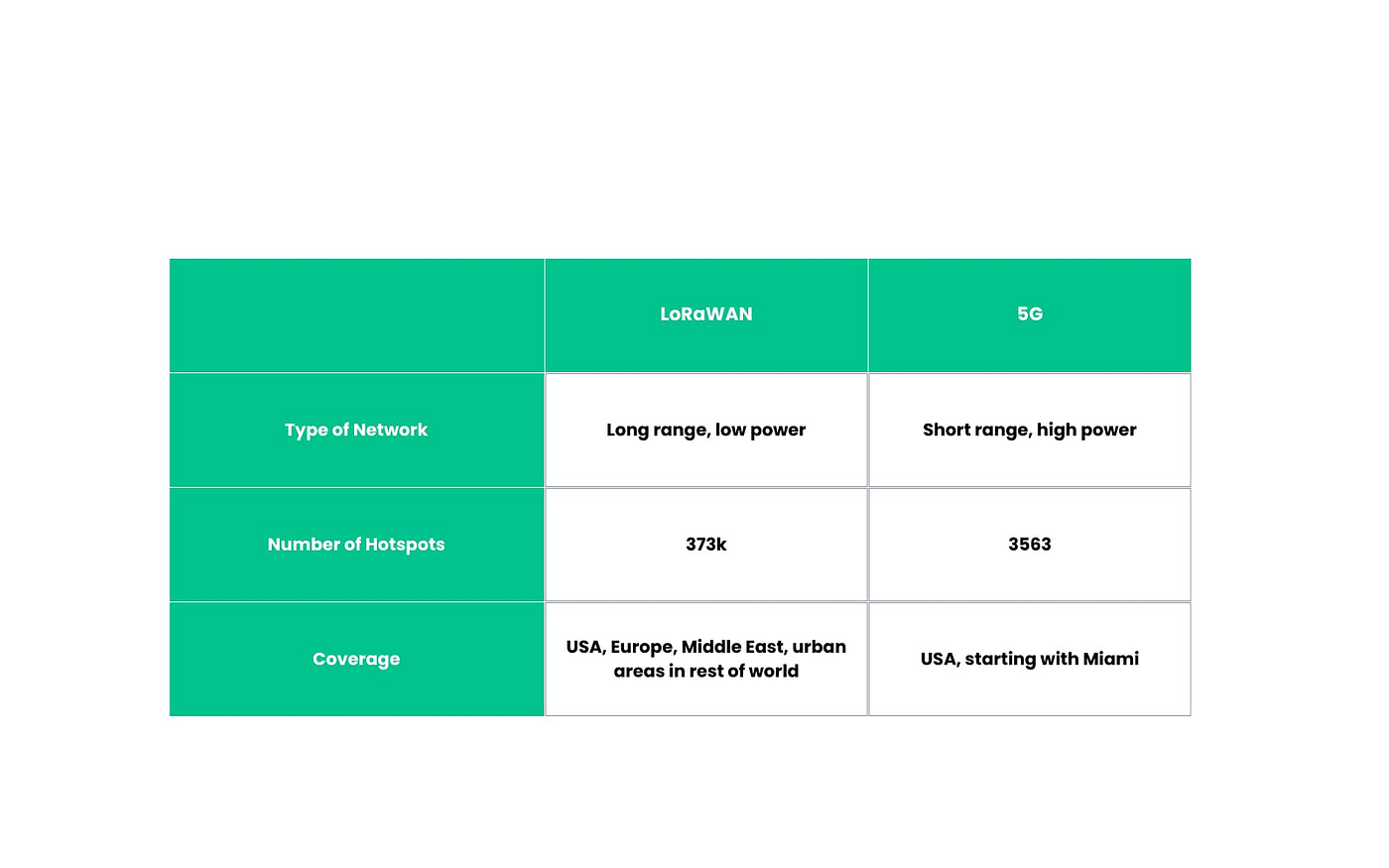
In terms of 5G, although Helium's development is constrained by compliance and market ceiling challenges, the collaboration between Helium Mobile and T-Mobile is helping Helium Mobile move towards mass adoption. The shift to the high-performance public chain Solana highlights Solana as fertile ground for the development of DePin projects.
Regarding compliance, the allocation and licensing of frequency bands in the U.S. are strictly regulated by the Federal Communications Commission (FCC). Authorized T-Mobile deploys 5G using the 600MHz band, while Verizon uses the 700MHz band for 5G deployment. As a latecomer, Helium chose the unlicensed CBRS GAA band to reduce deployment costs and solve compliance issues, which has a slightly smaller coverage area compared to mid-band frequencies and does not show significant advantages compared to U.S. operators.
In terms of market ceiling, 5G is a field strictly regulated by national policies, with most network operators globally being state-owned enterprises, and only a few being private companies closely related to the state. Therefore, from an international market perspective, it is difficult for Helium to replicate the U.S. 5G market experience overseas.
The strategic layout of migrating to Solana began in March this year, with Helium migrating from its own Layer 1 blockchain to Solana. The main reasons for choosing Solana are that Solana's latest state compression feature allows for the minting of a large number of NFTs at a very low cost, making the minting cost for nearly 1 million NFTs migrating to Solana only $113, saving a lot of expenses. These NFTs can serve as network credentials for Helium and verify hotspots, and can also integrate the functions of the entire ecosystem, including token gating and access for hotspot owners, making it very efficient and convenient. Additionally, there are many collaborative opportunities between Helium and projects like Solana Mobile Stack and the Saga phone that Solana intends to launch, creating a win-win situation for Solana, which wants to develop mobile phones, and Helium, which aims to become a 5G service provider. Furthermore, the obscure programming language and incompatibility with EVM make it difficult for developers to enter, resulting in Helium's inability to attract quality developers and a lack of excellent applications in its ecosystem, thus combining with Solana's ecosystem is a breakthrough.
Token Situation
HNT is used as Data Credits, utilized in various sub-networks when users seek hotspots (revenue side). Rewards obtained from deploying hotspots or transmitting data in the 5G SubDAO or IoT SubDAO can be burned and exchanged for HNT.
In terms of specific release allocation, 30% of the HNT released monthly is used for network data transmission, rewarding hotspots that transmit IoT device data, distributed according to data transmission ratios; 35% is allocated for Hotspots infrastructure rewards, mainly for mining rewards for hotspot owners, ensuring coverage as the network develops; 35% released monthly is allocated to teams and investors.

The actual total amount of HNT tokens is approximately 223 million, with an issuance of 43 million in the first year, halving every two years. The price fluctuations of HNT represent project revenue rights and governance rights while satisfying the speculative needs of token holders. The HNT inflation plan is as follows, currently generating 41,000 HNT daily.

HNT can be obtained by becoming a challenger, being challenged, acting as a witness, joining consensus groups, participating in network transmission, etc. (the most HNT rewards are obtained from witnesses and network transmission). HNT meets the needs of the two main participants in the Helium ecosystem:
1) Hotspot hosts and operators (supply): Hosts are rewarded with network tokens like IoT or MOBILE when deploying and maintaining network coverage. These network tokens can be exchanged for HNT.
2) Enterprises/developers/other users (demand): Enterprises and developers use the Helium network to connect devices and build IoT applications. Data Credits are a utility token pegged to the dollar, obtained through HNT burn transactions on the network, used to pay transaction fees for wireless data transmission on the network.
However, currently, the income generated from burning HNT is insufficient for Helium, while equipment providers receive more token rewards. Therefore, Helium has long suffered from a lack of application (demand side, i.e., low income), and the industry has faced criticism for lacking standards and poor developer and user experiences. However, the promotion of Mobile's low-cost eSIM cards seems to have opened up the serious demand-side deficiency.
2.3.1 MOBILE
MOBILE is the protocol token of the Helium Mobile Network and also serves as the governance token of the Helium SubDAO, achieving governance separation. MOBILE was introduced to the Helium Network through community proposal HIP-53.
Helium developer Nova Labs initially partnered with T-Mobile to launch commercial mobile smartphone services, first launching a $5 monthly plan in Miami. Recently, Helium Mobile launched a $20 wireless phone plan nationwide, combined with a free trial of SIM cards for the new phone from Solana Labs. This has sparked interest in the Mobile market.

MOBILE tokens are mined through 5G-CBRS and Wi-Fi hotspots, including both data transmission earnings and proof of coverage. The token distribution of MOBILE follows a similar minting plan to HNT, but with a maximum supply of 230,000,000,000 (230B). At the launch of the mobile network, 50B MOBILE were pre-mined and allocated to the network operation fund managed by the Helium Foundation. A portion of this allocation was distributed to active Mobile Network hotspots during the genesis period. The first year of MOBILE began on August 1, 2022, with the first batch of tokens minted on August 12, 2022.
The issuance plan will halve every two years, consistent with HNT's issuance halving.

The value of MOBILE tokens comes from two parts: one is redeemable for HNT through the programmatic treasury; SubDAO token MOBILE can be exchanged for HNT. To achieve this, each subnet in the Helium Network is allocated a certain amount of HNT pool based on its network utility score. The exchange ratio is set by the contract based on this network utility score algorithm; the second is governance utility in the subDAO. In the future, there may be more utilities, such as using staking to enhance coverage participation in hotspot proof.
The redemption price of MOBILE is calculated according to the following rules. All HNT rewards earned by 5G hotspots within a specified time are allocated to a pool, and MOBILE holders can burn their MOBILE to receive HNT distributed proportionally from the pool. For example, if all 5G hotspots collectively earn 100 HNT and there are 10,000 unused MOBILE, it means that burning 100 MOBILE would yield 1 HNT. This structure provides a value floor for MOBILE, allowing it to trade above its floor price based on its utility.
Helium Mobile currently has a payback period of 209 days.

2.3.2 IOT
Helium IoT SubDAO incentivizes IoT devices connected via LoRaWAN networks and balances the relationship between users and device providers. It can be understood as inheriting the use cases of the original Helium IoT segment.
Currently, the circulating supply of IOT is 24 billion (inflation follows the table below), in the early stages of chip distribution. MC is 68 million, FDV is 566 million; compared to Mobile's strong expansion, IOT use cases have not been fully explored.

The subDAOs derived from the Helium ecosystem are essentially a continuation of HNT's gradual approach to the later stages of distribution, which is beneficial for the continued development of the entire Helium ecosystem. After all, the main value capture is still in HNT, while expanding two sub DAO tokens with significant development potential serves as a narrative, creating a win-win situation for HNT, Mobile, and IOT.
Helium is the most funded and has the most complete product and economic model in the IoT+5G network. With the strategic layout of migrating to Solana, the current MC/price is relatively high. As a large-cap leading project, it will still enjoy the beta of the track. Recent gains confirm that the leading position in the DePin track will likely fall to the Helium ecosystem. Due to Mobile's slightly better chip structure than Helium and its position at the forefront of mass adoption, its status is also being priced.
3. Which DePin projects in the secondary market are worth paying attention to?
In addition to DePin on the Solana ecosystem, there are also projects with relatively mature ecological and project development in other ecosystems, including Dimo, IOTX (IOTEX), Streamr (DATA), WIFI Map (WIFI), etc., which were compared with Honey (Hivemapper) above. From the hotspot distribution map provided by Depinscan, it can be seen that the Helium ecosystem (IOT, 5G) has the widest hotspot distribution, with 363k devices deployed in Helium IoT and 38k in Helium 5, followed by Streamr with 83k devices deployed.
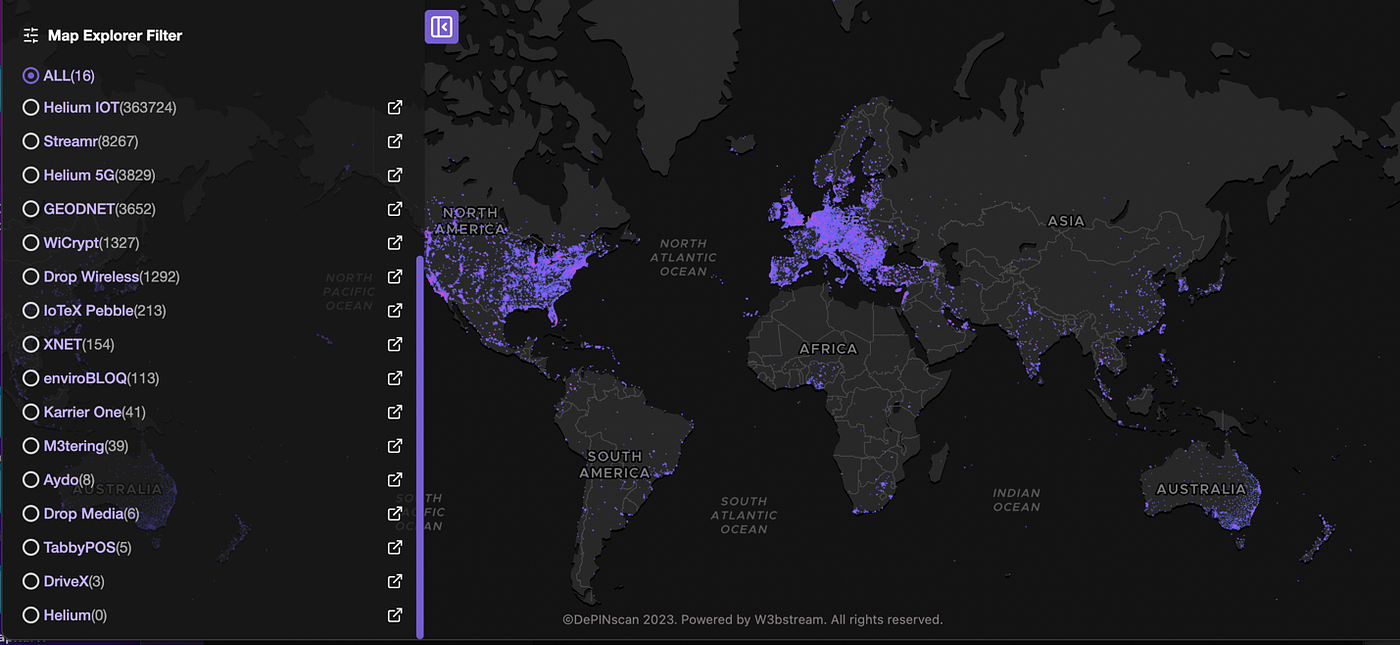
The applications in the IOTEX ecosystem have not shown significant dynamics compared to the Helium ecosystem, but have been continuously onboarding various DePin applications externally, while Helium's sub DAOs are more focused on building an endogenous ecosystem. Moreover, with Helium's migration to Solana, IOTEX, as an L1 with a unique layered architecture, is considered a more authentic DePin infrastructure, and its tokens have more scenarios and use cases. Currently, IOTX has an MC of 520 million and an FDV of 523 million, which has an advantage over Helium's market capitalization. However, IOTX is an old project that has been fully distributed, and its incentive measures and ecological vitality cannot be compared to the Helium ecosystem.
In September this year, Drop Wireless (formerly known as Nesten) transitioned to IoTeX's DePIN infrastructure. Drop Wireless operates a global LoRaWAN network with 1,000 nodes across 17 countries/regions. The company's focus extends to remote medical services provided in India and plans to continue expanding into Africa to meet significant healthcare needs. IoTeX supports Drop Wireless's native token, launched as XRC20 on the IoTeX chain, and facilitates decentralized data storage and transmission through W3bstream. This shift highlights IoTeX's role as a center for DePIN.
4. Conclusion
In the medium term, the leading projects in this track need to reach a market capitalization of at least $3 billion to enter the top thirty. Currently, based on market capitalization rankings, RNDR is at $1.6 billion (48th), Helium at $1.3 billion, Theta at $1.1 billion, IOTA at $860 million, and Mobile at $550 million. The entire track is undervalued.
As the leading DePin project on Solana, HNT has a strong ecosystem. Although its chip structure is not as favorable as Mobile's, it captures more value and will also benefit from the prosperity of sub DAOs. IOTX, as a DePin infrastructure target compatible with Ethereum, although it has not touched market hotspots (Solana), occupies an advantage in the subsequent Ethereum rally after the approval of the BTC spot ETF. Additionally, its current price is relatively cheap (MC 500 million); DIMO's MC still has room for growth, and the Internet of Vehicles track also has a grand narrative space; the collaboration between Mobile and T-Mobile may bring real external income, potentially leading the entire track.
The DePin track serves as a channel for mass adoption while linking to the AI sector, representing a track that can have a grand narrative and be chosen by capital. In the next decade, we can expect traditional institutions to inject incremental funds, and the involvement of traditional capital will disrupt the previous preference for purely on-chain economic speculation surrounding crypto-native applications, shifting towards investment opportunities with more off-chain logic and real-world impact. The importance and investment potential of DePin in the crypto development process align with the demand for new narrative funding in the crypto world.









